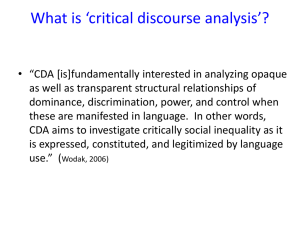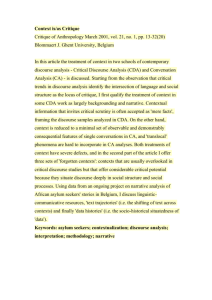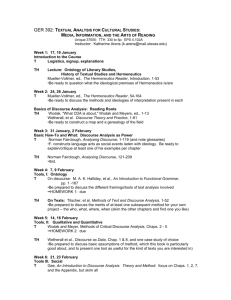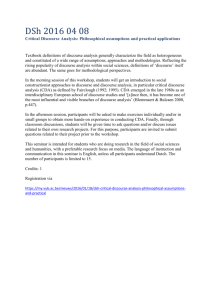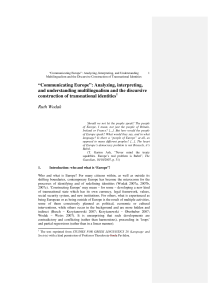Ruth Wodak, Professor in Discourse Studies
advertisement
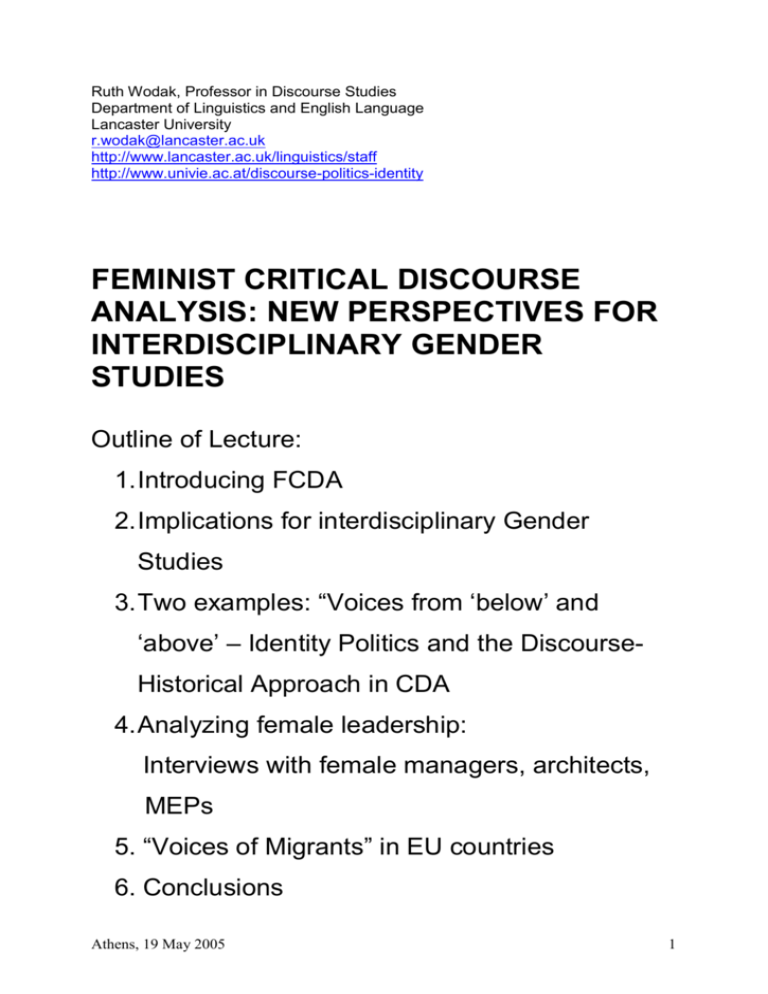
Ruth Wodak, Professor in Discourse Studies Department of Linguistics and English Language Lancaster University r.wodak@lancaster.ac.uk http://www.lancaster.ac.uk/linguistics/staff http://www.univie.ac.at/discourse-politics-identity FEMINIST CRITICAL DISCOURSE ANALYSIS: NEW PERSPECTIVES FOR INTERDISCIPLINARY GENDER STUDIES Outline of Lecture: 1. Introducing FCDA 2. Implications for interdisciplinary Gender Studies 3. Two examples: “Voices from ‘below’ and ‘above’ – Identity Politics and the DiscourseHistorical Approach in CDA 4. Analyzing female leadership: Interviews with female managers, architects, MEPs 5. “Voices of Migrants” in EU countries 6. Conclusions Athens, 19 May 2005 1 Programme of CDA (Principles) (Wodak 2001): (1) The approach is interdisciplinary. Problems in our societies are too complex to be studied from one perspective. This entails different dimensions of interdisciplinarity: theories draw on neighbouring disciplines and try to integrate other/new theories. Teamwork consists of different researchers from different traditionally defined disciplines working together. Lastly, also the methodologies are adapted to the data under investigation. (2) The approach is problem-oriented. Social problems are the items of research, such as “racism, identity, gender, social change”, which, of course, are and could be studied from manifold perspectives. The CDA dimension, discourse and text-analysis, is one of many possible approaches. (3) The theories as well as the methodologies are usually eclectic; i.e., theories and methods are integrated which are adequate in understanding and explaining the object under investigation. (4) Research in CDA should incorporate fieldwork and ethnography to explore the object under investigation (study from the inside) as a precondition for any further analysis and theorizing. This approach enables to avoid to `”fit the data to illustrate a theory”. Rather, we deal with bottom–up and top- down approaches at the same time. (5) The approach is abductive and retroductive: a constant movement back and forth between theory and empirical data is necessary. This is a pre requisite for principle 4. (6) Multiple genres and multiple public spaces should be studied, thus both intertextual and interdiscursive relationships. Recontextualization is the most important process in connecting genres as well as topics and arguments (topoi). (7) The historical context should be explicitly considered and integrated into the interpretation of discourses and texts. The notion of “change” (see principle 6) has become inherent to the study of text and discourse; the concept of “recontextualization” is relevant to the analysis of social change. (8) The categories and tools for the analysis are defined according to all these steps and procedures as well as to the specific problem under investigation. This entails some eclecticism, as well as pragmatism. Different approaches in CDA use different grammatical theories, although many apply Systemic Functional Linguistics in some way or other. (9) The problem-oriented approach entails the use and testing of middle-range theories. “Grand Theories” result in big gaps between structure/context and linguistic realizations (although some gaps must stay unbridgeable). (10) Practice and application are aimed at. The results should be made available to experts in different fields and, as a second step, be applied, with the goal of changing certain discursive and social practices. Thus, CDA might be defined as fundamentally interested in analyzing opaque as well as transparent structural relationships of dominance, discrimination, power and control as manifested in language. In other words, CDA aims to investigate critically social inequality as it is expressed, constituted, legitimized etc. by language use (or in discourse). Most critical discourse analysts would thus endorse Habermas' claim that Athens, 19 May 2005 2 "language is also a medium of domination and social force. It serves to legitimize relations of organized power. Insofar as the legitimizations of power relations, ..., are not articulated, .... , language is also ideological" (Habermas 1967, 259). The notions of power, history and ideology In contrast to other paradigms in discourse analysis and text-linguistics, CDA focuses not only on texts, spoken or written, as objects of inquiry. A fully "critical" account of discourse would thus require a theorization and description of both the social processes and structures, which give rise to the production of a text, and of the social structures and processes within which individuals or groups as social-historical subjects, create meanings in their interaction with texts (Fairclough & Kress, 1993, 2ff). Consequently, three concepts figure indispensably in all CDA: the concept of power; the concept of history; and the concept of ideology. Power relations are a struggle over interests, which are exercised, reflected, maintained and resisted through a variety of modalities, extents and degrees of explicitness (we distinguish between overt and covert power relations, such as physical violence and explicit gate-keeping procedures versus latent networks, for example). Ideologies are [cognitive] representations of practices formed from particular perspectives in the interest of maintaining unequal power relations and dominance. (Fairclough & Wodak 1997) The Discourse-Historical Approach (Reisigl and Wodak 2001) (Summary of some procedures of analysis): The specific discourse-analytical approach is three-dimensional: after (1) having established the specific contents or topics of a specific discourse, (2) the discursive strategies (including argumentation strategies) are investigated. Then (3), the linguistic means (as types) and the specific, context-dependent linguistic realizations (as tokens) are examined (4). There are several discursive elements and strategies which, in our discourse analytical view, deserve to receive special attention. We orientate ourselves to five constitutive questions: How are persons named and referred to linguistically? What traits, characteristics, qualities and features are attributed to them? By means of what arguments and argumentation schemes do specific persons or social groups try to justify and legitimize the inclusion or exclusion of some? From what perspective or point of view are these labels, attributions and arguments expressed? Are the respective utterances articulated overtly, are they even intensified or are they mitigated? Athens, 19 May 2005 3 According to these questions, we are especially interested in five types of discursive strategies, which are all involved in the positive self- and negative other-presentation. The discursive construction of “US” and “THEM” is the basic fundament of discourses of identity and difference. By “strategy” we generally mean a more or less accurate and more or less intentional plan of practices (including discursive practices) adopted to achieve a particular social, political, psychological or linguistic aim. As far as the discursive strategies are concerned, that is to say, systematic ways of using language, we locate them at different levels of linguistic organization and complexity: Strategy referential nomination Objectives Devices Construction / of in-groups Membership and categorization out-groups Biological, naturalizing and depersonalizing Metaphors and metonymies Synecdoches (pars pro toto, totum pro pars) Predication Labeling social actors more Stereotypical, or evaluative attributions of negative less positively or negatively, Or positive traits deprecatorily or appreciatively Implicit and explicit predicates argumentation Justification of positiveTopoi or used to justify political inclusion negative attributions Or exclusion, discrimination or preferential treatment perspectivation, Expressing involvement Reporting, description, narration or quotation of framing or discourse Positioning speaker's point (discriminatory) of events and utterances representation view intensification, Modifying the epistemic status Intensifying or mitigating the illocutionary force or mitigation of a proposition (discriminatory) utterances Table 1: Discursive strategies for positive self- and negative other representation Feminist CDA (FCDA) For feminist CDA, the focus is on how gender ideology and gendered relations of power are (re) produced, negotiated and contested in representations of social practices, in social relationships between people, and in people’s social and personal identities in texts and talk (Lazar 2005, 11). The marriage of feminism with CDA, in sum, can produce a rich and powerful critique for action” (Lazar 2005, 5) Suggested principles for research in FCDA (Wodak 2005a): 1) Breaking up dichotomies! 2) Differentiating the range of gendered identities! 3) Relating gender to other identities, such as ethnicity, social class, profession, culture, political affiliation, etc.! Interdisciplinarity necessary! 4) Analyzing gender in socio-political, situative, interactive and historical contexts! (Gender functions as one interpretative category in all contexts; gender enters as a social relation into all contexts) Athens, 19 May 2005 4 5) Theorizing and analyzing the particularly insidious and oppressive nature of gender as an omni-relevant category in most social practices (in the interplay with 4). 6) Raising as problematic the notion of scientific neutrality (all knowledge is socially constructed!) 7) Viewing gender as ideological structure. 8) Deconstructing the hegemony and symbolic violence of gender in our societies! (i. e. focusing on the latent, covert mechanisms of discrimination; patriarchal gender ideology is structural, similar and to and combined with other discriminatory practices in our societies). 9) Contesting the prevailing gender ideology by making it transparent; 10) Viewing gender not only as discursively constructed but having a material base as well (different salaries for the same job for men and women, for example); 11) Reflecting one’s own research activities critically (This entails, for example, including female scholars from non-Western societies; see Lazar 2005, 19ff.). Text Examples: 1. Members of European Parliament (collected 1997 by Carolyn Straehle and Gilbert Weiss in Strasbourg and Brussels) (sample: 28 interviews) Example 1(*) (Dutch MEP) when I – entered the parliament – Orientation (lines 1-3) on my first report it was about Leonardo I don’t know if you know: ((smiles)) well – I said “I’m going to speak to the commissioner” and – I - / I knew – he only speaks very bad French and my eh my French was very bad as well. so I said “I want to have interpretation” So – I went to the commissioner Complicating Actions (lines 4-14) with a very good int / int / interpreter and I / I / I / I talked more than an hour with him. because we talked the same about it and at the end he said – “well: I have here the advice of my: civil servants but I – agree with you: and this and this and this all goes through. – ” so you have to be: - eh: I don’t know h / how do we call it in English in / I in the Netherlands we say (brutaal) so you have to: ((laughs)) be polite Evaluation (lines 16-20) but you have to – you: / you mustn’t be / you mustn’t sit behind your – / your desk. – because that doesn’t help. ((laughs)) Athens, 19 May 2005 5 but then then you have the worse system that I tried several times Coda (22-31) then you have the Council. – a:nd – it’s very difficult eh: to negotiate with the Council is my: - / eh is my experience: it’s possible to do: bu:t - - now they have their own strategy: and their own – reasons: eh: and they don’t like the power of the parliament so: the: / the / that’s - / that’s the most difficult part. Example 2 (Swedish MEP) I figure here the most common – eh civil - job. – for an MEP is eh to be a lawyer. me myself I’m far from that the job I had doesn’t even exist outside Scandinavia. so: - it’s a sort of a social teacher –so so I’m / I’m very in / an: / a very special bird in this a: IF mhm mhm so now you don’t feel like you - fit into sort of a typical MEP eh ME no. no: no: I’m not. I’m left I’m a woman I’m Swedish and I’m also everything/everything’s wrong. (laughs) 2. Managers, Architects (collected 2001/2 by Ina Wagner and Andrea Birbaumer in Vienna) (sample: 18 interviews) Manager 1 Shall I tell it again? When I was with Nofro last year – I was in charge of two projects, that was Memphis, that was jet2web. They were two mega-projects. I think in the end they brought in around seven grand in total for the company. And of course developing Regina and Nicole as their mentor, and on top of that this whole structural mish-mash that they had. It was just too much on my plate, and I already had an offer with F. So there was this tension, and also this emotional charge, some people knew how it was with me, and they remember, they didn’t want me to go and so on. And then I fell ill. And it was the case that a couple of times I ignored my illness, and then I just got super-ill, and lay around at home, totally bunged up, knackered. Yes, that was my job. I just have this loyalty to a task. And that’s what is missing here. E.g. I now have my Management, where I studied this last year, through this I have found a theory that says some managers are ‘task oriented’. Either they have e.g. a very clear task and loads of power. Yes, then they feel good, then they can enjoy themselves. Then there’s the variety where where they don’t have any definition at all and don’t have any power, then they start fighting, the ‘task oriented’ Athens, 19 May 2005 6 ones. They feel good. And then there is this other interpersonal level that is where the task is not clear, and they have no power or the power is not clear. And that is the ‘relation oriented’ And he interviewed me, and now he has my face on the cover, just as I was starting, as a cartoon, as an illustration. That’s called Global Citizen. And I really had to laugh, because like Andy Warhol everyone has to be famous for five minutes or ten minutes. And now I have my face on a cover, and that’s enough. That is enough now, yes, it says Global Citizen and a ‘stupid’ article. And we’re like that, for me, I observe that, and I think, yes, and what do you want now? It’s like Ticks now. I never asked for that or wanted it, but it’s more or less okay like that, it’s your exam paper leaving school, so to speak. Carry on. Carry on. Manager 2 H: Yes, it was in the right place at the right time and promoted in the right way. Yes, somehow it ended up pretty advantageous. And it also worked really well. I mean, yes, well, it was a super thing. And of course I learnt an incredible amount. It was also incredibly difficult. Because it actually was a big project, for what I had already… I mean, I had done designs for some benches or armchairs or sofas, more as sort of little, tiny things. And then, I don’t know, building half a neighbourhood. No, that was really super. And originally I had this idea that when I go to an office, I would actually rather do competitions and design some stuff. I’ll just say a keyword, in my opinion the beginning and end of success and failure is simply the internal … how people work together, how they spend their time. And they should spend their time so that you like going somewhere and working. Work isn’t always great. But when you get on with nobody, don’t feel understood or for whatever reason, justified, unjustified, feel emotionally unsatisfied, then nothing will help, the money won’t help. In the end, at some point you can pay more and even more, but at some point you say I couldn’t care less about money, I actually want to have some kind of environment in which I feel good. When I think, I sit around there for at least eight hours. I spend more time with these people than probably with all my… Kunstszene [art scene], Vice-director well, it was always ‘learning by doing’. Well I never had any kind of mentor or anything, who said “Look, girl, it’s like this”, but it was always like this: Right, it doesn’t work like this, yes, and it does work like this. Well apart from with technology. Okay, there I really had people who initiated me, yes, well that would have been a bit harsh. So then I left the theatre. Well I hardly ever had times where I really had to look actively. On the contrary, I always had to say “No, I can’t”. So I didn’t do anything, didn’t organise anything, and no clue, didn’t go to courses or build up networks on purpose. It really just happened. Athens, 19 May 2005 7 3. Focus-groups with Migrants in Austria (Turkish women and men) (XENOPHOB Project, EU, 5th framework) (collected by the Austrian team researchers Michal Krzyzanowski and Fleur Ulsamer) SCH-F6 (Turkish woman) One day here in school I went into this room because I had to do some ironing (.) and a girl who was standing vis á vis of us said ahm (.) I was talking to her [F2] (.) ‘hey start speaking German’ (.) ‘hey that’s none of your business what I am talking’ (.) I really wanted to kill her (.) it’s none of her business what I am talking EE-F4 (Turkish woman) (2.0) I have a cultural heritage I have a long history I have a language (.) which I want to keep I want to (.) […] (1.0) I want to HAVE them and this is my property (.) ENE-M3 (Turkish man) yeah BUT what I know of-from people who who have studied here who are living here I think they have they have a lot of difficulties in getting jobs in their fields I-I-I I know that many foreigners who studied here in the Austrian universities but they cannot get jobs in their fields although they speak German well they know am-that language and you find that people doing completely different jobs from one who studied IT or medicine but he can be a taxi driver ….(…) ENE-M3: I do not think that is easy for non-Austrians to get jobs even if they ARE qualified and even if they even if they have Austrian citizenship Turkish woman: Well me for example I do feel like being in between (1.5) I feel as neither nor a foreigner (.) or or well I don’t know (.) sometimes when I am between the Austrian girls (.) then I do feel like a foreigner (.) whereas I am not any I don’t know I am not any pure foreigner I was only born here but my roots are in Turkey (0.5) and that is why I only know life as it is here (.) the life here and I do not know what it’s like over there that is why when I go there I feel myself somehow different because because they are also well for example I do not know Turkish THAT well and so (0.5) and (0.5) well when I go there then they say’ that I am born there’ and so (.) and here when I come here then they say that I am I am well that I am Turkish (0.5) I am Turkish and so but (.) I am one but ((laughs)) I am not saying now that I am not but well I fell-I feel in between I don’t know well I feel (AT-FG5-F2)i,ii Selected References: Axeli-Knapp, G. (1995) TraditionenBrüche. Entwicklungen feministischer Theorie. Freiburg i. Br.: Kore. Athens, 19 May 2005 8 Benke, G. and Wodak, R. (2003), Remembering and forgetting: The discursive construction of generational memories.. In M. Dedaic and D. Nelson (Eds), At War with Words. Berlin/New York: Mouton de Gruyter, pp 295-330. Billig, M. (1989), Ideological Dilemmas. London: Sage. Braithwaite, M. (2000), Mainstreaming Gender in the European Structural Funds. Paper prepared for the Mainstreaming Gender in European Public Policy Workshop, University of Wisconsin-Madison, October 14-15 2000. De Francisco, V. (1997), Gender, Power and Practice: or, putting your money (and your research) where your mouth is. In R. Wodak (Ed.) Gender and Discourse. London: Sage, pp. 37-56. Delanty, G., Jones, P., Wodak, R. (Eds.) (forthcoming) Migrant Voices. Liverpool: LUP. Gherardi, S. (1996) Gendered Organizational Cultures: Narratives of Women Travellers in a Male World.Gender, Work, and Organization Vol.3/4, 187-201. Holmes, J. & Meyerhoff, M. (Eds.) (2003) Handbook of Gender and Discourse. London: Blackwells. Kendall, Sh. and Tannen, D. (1997), Gender and Language in the Workplace. In: R. Wodak (Ed.) Gender and Discourse. London: Sage, pp. 81-105. Kienpointner, M. (1992), Alltagslogik. Struktur und Funktion von Argumentationsmustern. Stuttgart-Bad Cannstatt: frommann-holzboog. Koller, V. (2004) Metaphor and Gender in Business Media Discourse: A Critical Cognitive Study. Basingstoke: Palgrave. Kotthoff, H. & Wodak, R. (Eds.) (1997) Communicating Gender in Context. Amsterdam: Benjamins. Labov, W. and Waletzky, J. (1967), ‘Narrative Analysis. Oral Versions of Personal Experience’. In: J. Helm (Ed.) Essays on the Verbal and Visual Art, Seattle: University of Washington Press, pp.12-44. Lazar, M. (Ed.) (2005) Feminist Critical Discourse Analysis. London: Palgrave Linde, Ch. (1993), Life Stories. The Creation of Coherence. New York: Oxford University Press. Martin Rojo, L. and Gomes-Esteban, C. (2002), Discourse at Work: When Women Take on the Role of Managers. In G. Weiss and R. Wodak (Eds.) Critical Discourse Analysis. Theory and Interdisciplinarity, London: Palgrave/MacMillan, pp. 241-271. Mazey, S. (2000), Introduction: Integrating gender-intellectual and ´real world´mainstreaming. In S. Mazey (Ed.) Women, Power and Public Policy in Europe. Special Issue Journal of European Public Policy 7/3, pp. 333-345. Reisigl, M. & Wodak, R. (2001) Discourse and Discrimination. London: Routledge. Sassen, G. (1980) Success Anxiety in Women: A constructivistr Interpretation of its Source and its Significance.Harvard Educational Review 50, 13-23. Schiffrin, D. (1996), ‘Narrative as Self-Portrait: Sociolinguistic Constructions of Identity. Language and Society 25, pp 167-203. Schiffrin, D. (1997) ‘The Transformation of Experience, Identity, and Context’, in G. Guy, C. Feagin, D. Schiffrin, and J. Baugh (Eds.) Towards a Social Science of Language. Papers in Honour of William Labov, Volume 2, Social Interaction and Discourse Structures, pp. 41-55. Amsterdam/Philadelphia: John Benjamins. Sunderland, J. (2004) Gendered Discourses. London: Palgrave. Trix, F. and Psenka, C. (2003) Exploring the colour of glass: letters of recommendation for female and medical faculty, Discourse & Society, 1, vol.14, no 2, pp.191-220. Wagner, I and Wodak, R. (in prep.) Narratives of Successful Women: Performing Success? Wagner, I. (2003) Women Professionals in Innovative Companies (unpubl. Ms.). Wagner, I et al. (2003) Widening Women’s Work in Information and Communication Technology. Vienna, Institute for Technology Assessment and Design (Project Report, EU-Project IST 2001-34520) Athens, 19 May 2005 9 Weiss, G. & Wodak, R. (Eds.) (2003) Critical Discourse Analysis. Theory and Interdisciplinarity. London: Palgrave. Wodak, R. (2005) Gender Mainstreaming and the European Union: Interdisciplinarity, Gender Studies and CDA. In Lazar, M. (Ed. (2005), pp. 90-114. Wodak, R. (2005) Discourse, In Ph. Essed. D.T. Goldberg, A. Kobayashi (Eds.) A Companion to Gender Studies, Oxford: Blackwells, pp.: 519 - 530. Wodak, R. (2003) Multiple identities: The role of Female Parliamentarians in the EU Parliament. In: J. Holmes and M. Meyerhoff (Eds.): The Handbook of Language and Gender. London: Blackwell, pp. 671-698. Wodak, R. (2004) National and transnational identities: European and other identities oriented to in interviews with EU officials. .In: R. Hermann, Th. Risse, M. Brewer (Eds.). Transnational Identities Becoming European in the EU, New York: Rowman & Littlefield, pp. 97 – 128. Wodak, R. (2001) The Discourse-Historical Approach. In Wodak, R. and Meyer, M. (Eds.) (2001) Methods of CDA. London: Sage. Wodak, R. (1997), Introduction: Some important issues in the research of gender and Discourse. In: R. Wodak (Ed.) Gender and Discourse. London: Sage, pp. 1-20. Wodak, R. (Ed.) (1997). Gender and Discourse. London: Sage. Wodak, R. and Van Dijk, T. A. (Eds.) (2000) Racism at the Top. Klagenfurt: Drava. Wodak, R. and Schulz, M. (1986), The Language of Love and Guilt. Mother-DaughterRelationships from a Cross-Cultural Perspective. Amsterdam: Benjamins. i Key to Coding (applicable to all quoted examples): (a) country (AT = Austria, CY = Cyprus, FR = France, DE = Germany, IT = Italy, SE = Sweden, PL = Poland, UK = UK); (b) number of a focus group discussion in a particular country (FG 1, FG 2, FG 3, etc.); (c) participant’s gender (F = female, M = male) and number (1,2,3,4,5, etc.). ii Transcription Symbols: SYMBOL M1, M2, (or other) (.) (6.0), (8,0), (9,0), … (unread. 6.0) [ Mhm. Eeeeeh ((leans back)),((laughs)) [Heimat] I would not say so THIS (↑) (↓) Athens, 19 May 2005 FUNCTION Speakers Short Pause Longer Pause (six seconds, eight seconds, nine seconds, ..) Unreadable Elements of Speech Overlapping Speech Para-verbal elements Non-verbal Behaviour Elements of original language (difficult to translate) Normal Speech Accentuated/Stressed Element of Speech Rising Intonation (if significant) Falling Intonation (if significant) 10
